The Orange Box: Half-Life 2: Episode 2 etc. Review
The Orange Box: Half-Life 2: Episode 2 etc.
Episodic gaming at its very, very best.
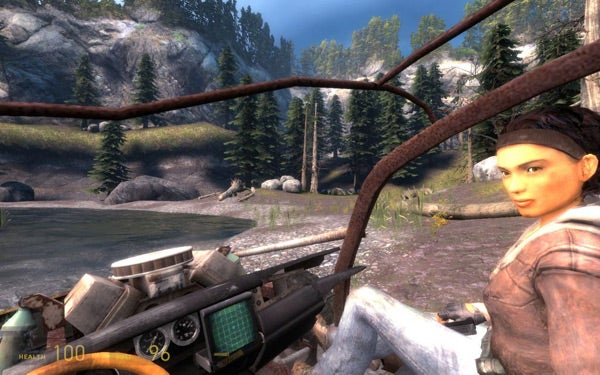
Verdict
”’Platforms: PC, Xbox 360, Playstation 3 – PC & Xbox 360 versions reviewed.”’
Last year at X06 I saw Half-Life 2 running on the Xbox 360 for the first time and, to be honest, I felt worried. When the game launched on the PC at the tail end of 2004, its killer combination of the Source graphics engine and powerful real-time physics was groundbreaking. Overnight, Valve had upped the ante and produced something that made every other 3D shooter on the market look stale. Last year, however, with G.R.A.W. and Oblivion released and Gears of War, The Darkness and Call of Duty 3 on the way, I felt concerned that it was Half-Life 2’s turn to look like its shelf-life had expired. How could the Source engine stand up to the might of Unreal 3 technology? Would the gameplay be so enthralling in a world where F.E.A.R. and S.T.A.L.K.E.R. have revolutionised AI, and where every game now boasts an advanced physics engine (at least on the box).
The Orange Box shows me how wrong I was. It’s not just that I underestimated Source, but that I reckoned without something far more important. Valve isn’t just about technology, it’s about using that technology to set up incredible moments where gameplay and cinematic brilliance fuse, and chaining these moments together in a powerful narrative. If the Half-Life 2 saga tells us anything it’s that nobody in the FPS genre – with the vaguely possible exception of Bungie – does it better.
In the unlikely event that you come to The Orange Box having never played Half-Life 2, then you’re in for a treat. Playing through the early stages on the 360, I’m struck by how strong the beginning is and how atmospheric and well-developed its dystopian urban landscape seems. Like Bioshock’s Rapture with its hordes of nutty splicers, City 17, its oppressed population and its brutal Combine authorities have a sense of concrete reality that other FPS settings so often miss. 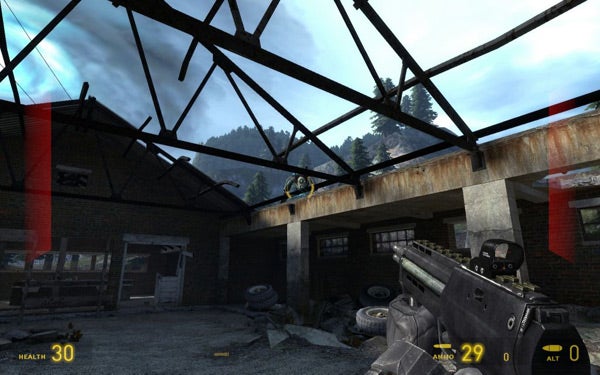
I’m also struck by how well the game develops, throwing in new equipment and new demands at you just when things threaten to get samey, then expecting you to make the most of each situation. There are a couple of dull stretches, but not so many that they spoil things. From the air-boat sequence on the canals to the return to Black Mesa, the trip through the horrors of Ravenholm, Nova Prospekt and the final battle back in City 17, there’s a real sense of growing scale and dazzling ambition. Given the chance to cut loose with the gravity gun, flinging scenery around and causing Combine destruction on a massive scale, every player gets a chance to create their own big pay-offs. There’s a reason this game is so venerated. 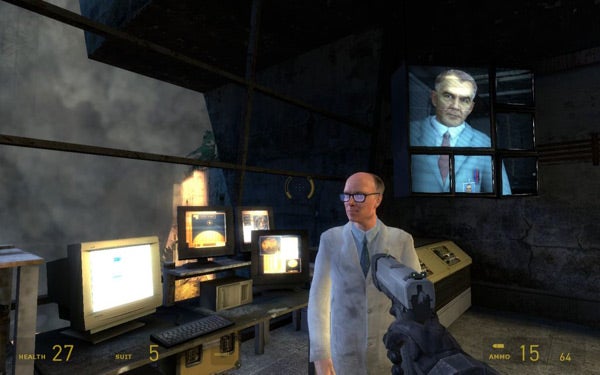
And maybe it’s the same reason why Episode One is so often underestimated. Yes, it’s short. Yes, after a storming start with a superchared gravity gun in the Combine citadel, it seems to step back from Half-Life 2’s huge scale. Yes, some chapters seem to be retreading stuff we’ve already done in Half-Life 2. However, it’s still an incredibly strong piece of FPS action and storytelling. The key to it is your computer-controlled companion, Alyx Vance. Some criticised her seeming indestructibility, others her lack of shooting skills, but her importance isn’t so much on a gameplay level as on an emotional one: she adds a warmth to the game and makes it a far less lonesome experience than your average hard-guy-against-the-odds FPS. What’s more, within its tiny four to six hour running time Episode One fitted in more memorable moments than just about any FPS last year. Remember the sequence with the antlions in the multi-story car park? The terrifying wait for the elevator as the zombies swarm? The super string of shoot-outs in the abandoned hospital? Any good FPS would be proud to have just one of these.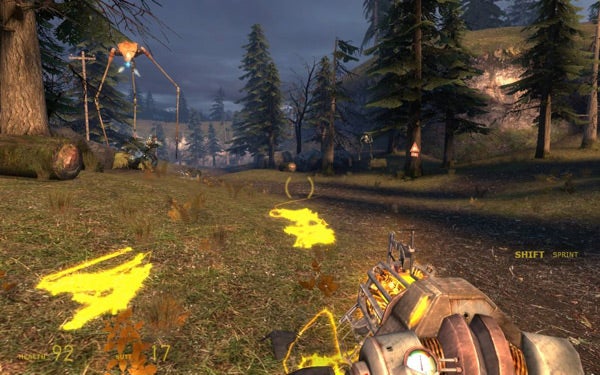
And so we come to Episode Two. In many respects, it’s a case of taking what was good about Episode One and applying it to a wider canvas reminiscent of the original Half-Life 2. Alyx returns with her shooting skills upgraded, a new system of pre-rendered physics actions makes for some spectacular destruction, and more of the episode takes place outdoors than in any previous instalment.
The episode begins in the aftermath of the destruction of City 17 and essentially plots Gordon and Alyx’s escape to a rebel research base in the mountains. Carrying data stolen from the Citadel in Episode One, the pair are the target of Combine attacks, but they also face peril from Antlions and Zombies en-route. 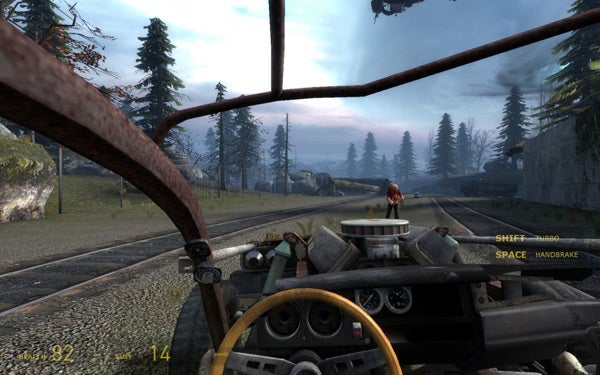
Now, I’ll admit I wasn’t entirely swayed by the first third of the game, dominated as it is by a long underground sequence that only occasionally kicks into high gear. However, what follows is so regularly breathtaking that, by the time your six or seven hours are up, you’ll be more than satisfied. An initial clutch of wilderness sections, punctuated by vicious attacks from Combine forces – including a new enemy, a junior-sized Strider called the Hunter – are thrilling, but they only set you up for a dazzling final battle where all hell seems to be breaking loose and the odds look bad for humanity. Arguably trumping the final sections of Half-Life 2, it’s one of the best bits you’ll find in any FPS, partly because, in an era when narrative-led FPS games seem to be channelling the player through tighter and tighter corridors, Valve has had the confidence to give you a wide open space, a huge challenge and just about enough gear to get you through it. It’s dazzling stuff. The finale, meanwhile, is one of the most gut-wrenching in recent history.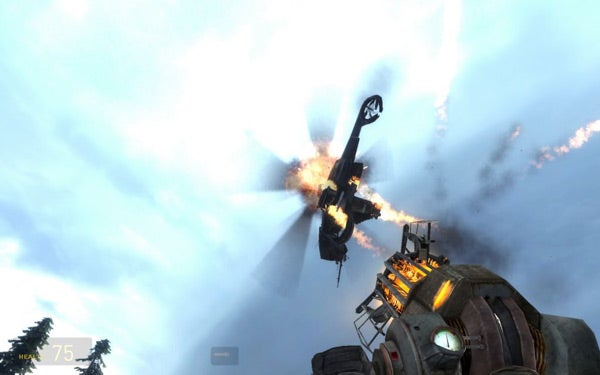
It’s during that final section that you might also hear of Aperture Science for the first time – a sure sign that another Orange Box inclusion, Portal, is more closely tied into the saga than we first thought. Rather than the quick, experimental add-on some might have expected, Portal is a hugely accomplished first-person puzzler. Developed by the team behind the indie hit, Narbacular Drop, now safely ensconced at Valve HQ, it puts you in the shoes of an unwitting human test subject inside a mysterious research facility. Armed with the portal gun – a device which can create instant dimensional gateways – you’re expected to make your way through a series of gruelling and hazardous test chambers, each putting more of your intellectual capabilities to the test. The trick isn’t so much where you put your portals, but when and in which sequence. What’s more, momentum is transferred as you move through the portal, so many of the puzzles require you to think carefully about this as well.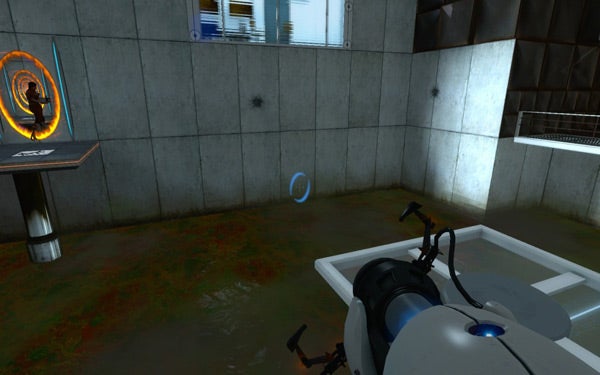
The overall effect resembles a combination of FPS, puzzle game and platform game, and there’s much to admire both in the way it drip-feeds new concepts and challenges, and in the way that a pitch black grim humour makes the game feel less cold and abstract than it first appears. The biggest issue with Portal is its length – you’ll probably crack it in two to four hours on your first attempt, though there are remixed challenges and time trials once that’s done. All in all, this is one of the most constantly surprising and interesting games I’ve played this year, and one that leaves you desperate to see what would happen if aspects of Portal’s gameplay were integrated into the wider Half-Life 2 series. Here’s hoping that’s a direction Valve has considered.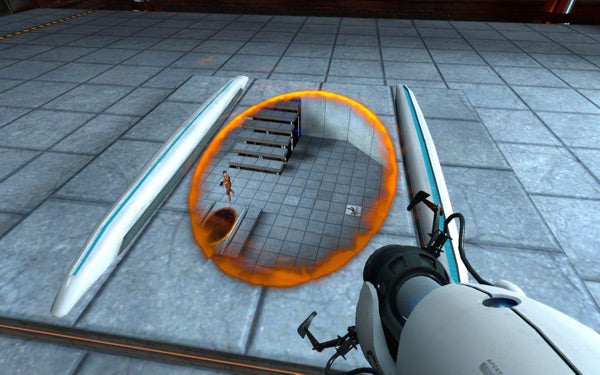
The final gift in the Orange Box probably needs no introduction. Team Fortress 2 has already developed an enviable reputation in its PC beta stage, and closer inspection in the PC and 360 versions only shows how justified that reputation is. Just aesthetically, the decision to pursue a Pixar-like cartoon graphics style seems inspired; Team Fortress 2 instantly looks and feels unlike any other team-based action game out there. However, what I didn’t expect was how well it fits the gameplay. In a game where the class players choose has a huge impact on gameplay, being able to instantly discern who is who at a distance is vital. You know that big, bald heavy weapons dude can take a kicking, but he’s slow to move and slow to fire, while the scout might be weak, but he’s ludicrously fast and packs a massive punch up close. 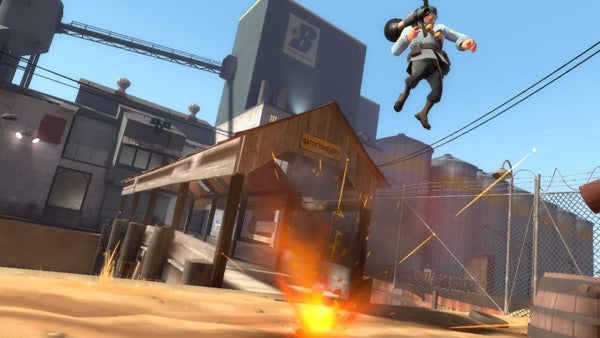
Without vehicles or a vast range of support options, Team Fortress 2 isn’t as sophisticated a game as Enemy Territory: Quake Wars, but there’s more than enough tactical depth in the use of class weapons and abilities and the layout of the maps to give it staying power. Meanwhile, it’s a lot more accessible, straightforwardly entertaining and – importantly – newbie friendy. It will be interesting to see how it withstands the assault of Unreal Tournament 3 on the PC and Halo 3 on the 360 in the next few months. I could be wrong, but I imagine that both this and iD’s new favourite will be safe keeping servers busy for some considerable time to come.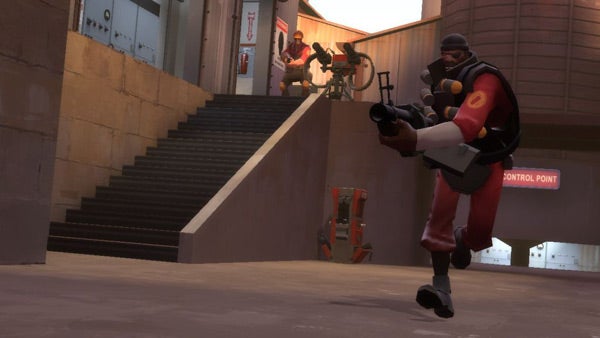
OK. Now back to where we came in. It’s true that the Source engine no longer has the power to inspire awe. Even with its rightly admired HDR lighting engine and still unsurpassed water effects, Half-Life 2: Episode Two lags behind Gears of War and G.R.A.W. 2 for realistic character modelling and gritty surface detail. But you also can’t deny that it looks better on lower-spec hardware than either of those games, or that it still produces scenes of real beauty – particularly in the outside chapters towards the end of Episode Two. Most of all, it still meshes in with clever and consistent art direction to build convincing worlds. Look at the decay in Episode One’s hospital, the sylvan wonders of Episode Two’s forests, the crazy, cartoon worlds of Team Fortress 2 or the sinister, sterile environments of Portal and it’s hard to find anything to complain about. Meanwhile, in terms of dialogue, surround sound effects and the understated use of music at key moments, the guys at Valve can still hold their head up with Bungie, Epic and the rest, if not higher.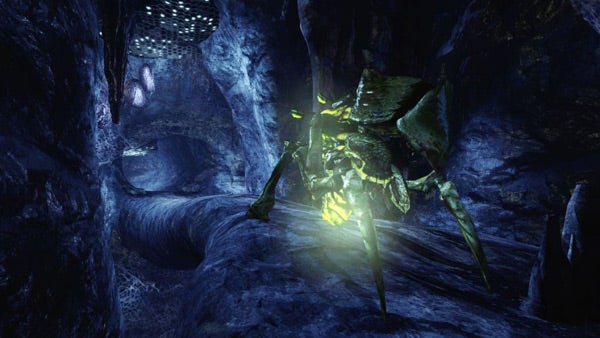
One final note. If I haven’t distinguished much between the PC and 360 versions here, it’s a testament to how skilled the translation from computer to console is. Half-Life 2 itself benefits a little from the addition of HDR lighting, and the biggest compliment to the controls is that I didn’t really notice anything different once I’d started playing, bar the odd incident in Portal where I wished for a speedier turn-speed in order to make a particularly tricky shot. There have also been some teething troubles with Team Fortress 2 online, but Valve seems to be on the case. If you have a 360 and only a basic PC, then there’s no reason bar the higher price to avoid the console version. How the PS3 port fares remains to be seen.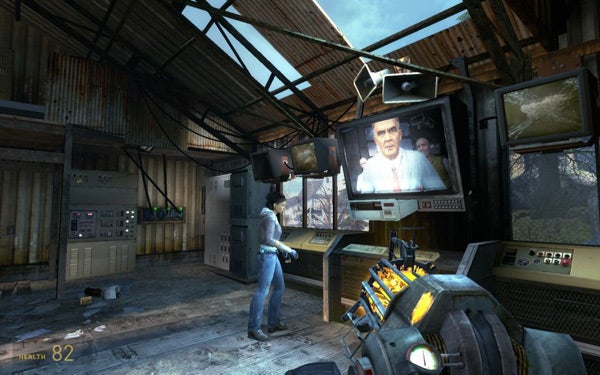
The most important thing to take away from this lengthy review is that it doesn’t really matter which platform you get The Orange Box on, as long as you do go out and get it. Other reviewers have called it the best value pack in gaming history, and there’s nothing I can say in disagreement. In fact, were it not for Bioshock, this would be the greatest FPS experience of the year so far. Keep your hair on, Halo fans; you know it’s true. Even with Bioshock, there’s an argument that the sheer quantity of quality entertainment here still makes The Orange Box a contender. If Episode Three finishes off the Half-Life 2 saga in similar style, then Valve will have pulled off one of the greatest, most ambitious achievements in gaming history. At the moment, I’ve little doubt it will succeed.
”’Verdict”’
Seen as one long saga, Half-Life 2 re-asserts its position as the greatest of modern FPS series. Portal and Team Fortress 2 provide the thick, sweet icing on the cake. Unmissable.

